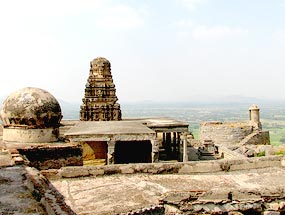Gingee Fort is one of the few forts of Tamil
Nadu that have survived the travails of time. Explore Gingee Fort of
India.
Gingee Fort

Location: Villupuram District, near Chennai
(Tamil Nadu)
Founded By: Chola Dynasty and then, Vijayanagar Empire
Founded In: 9th century
Timings: 8:00 am to 5:00 pm
Status: National Monument
Gingee Fort counts amongst the few forts that are still in existence in
Tamil Nadu. It is situated in the Villupuram district, which is situated
at a distance of approximately 160 km from the Chennai city of India.
The district also lies close to the union territory of Pondicherry. One
of the most unassailable citadels of India, the fort was given the name
of 'Troy of the East' by the British. The place where the Gingi fort
today stands, was once the site of a small fort built by the Chola
dynasty in 9th century.
However, when the Vijayanagar Empire took over in the 13th century,
modifications were carried out at the fort. It was then that the fort
was elevated to the status of an impregnable citadel, which was intended
to protect the small town of Gingee. The fort also served as the head
quarters of the Gingee Nayaks, when they used to exercise their
domination over the state of Tamil Nadu. The main reason behind the
establishment of this fortress was to serve as a protection against any
Muslim invasions.
Gingee fort came under the occupation of the great Maratha leader,
Shivaji, in the year 1677. He recaptured the fort from the Bijapur
sultans who had initially taken over its control by defeating the
Marathas. During Shivaji's reign, the fort was further strengthened. The
decade of 1690s saw Gingi fort being constantly laid under siege by the
Mughals. However, a full decade passed before they could take over the
fort. From the Mughals, Gingee fort fell into the hands of the Carnatic
Nawabs, who lost it to the French in 1750.
Before the British took control of the fort in the year 1761, it
briefly went into the hands of Hyder Ali. Gingee fort spreads over three
hills, which have been connected through its walls. The total area
enclosed within the fort is approximately seven sq km. It is situated at
a height of approximately 800 feet and stands surrounded by a 24 m wide
moat. Gingee fort comprises of a number of structures inside its
premises, like Kalyana Mahal (marriage hall), granaries, prison cells, a
military gymnasium, etc.
There is also a temple inside the fort, dedicated to a female Hindu
deity, known as Chenjiamman. The ramparts have a sacred pond, which is
known as 'aanaikulam'. The naturally hilly terrain of Krishnagiri,
Chakkilidrug and Rajagiri hills make up the walls of Gingee fort. The
gaps in these natural walls have been sealed with the help of the main
wall, which has a breadth of approximately 20 m. Gingee fort was
declared a National Monument in the year 1921 and is presently under the
control of the Archeological Department.


